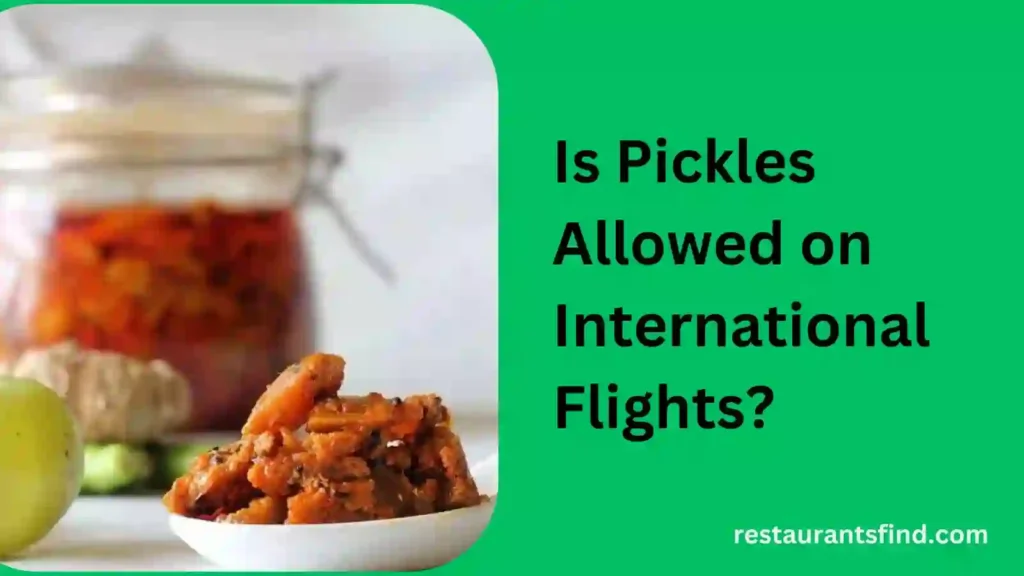Have you ever prepared your baggage for a trip home to India, only to be disappointed at the security checkpoint when your favorite jar of pickles is flagged?
You are not alone! Many passengers ask if they can genuinely bring pickles on international flights. This question, while appearing easy, might be tricky depending on the airline, destination, and type of pickle.

It becomes unexpectedly important for the Indian tourist to comprehend the world of pickles, from its tart variety to travel laws.
In this guide, we’ll look at both the tasty and practical aspects of pickles, including the various types, their significance in Indian cuisine, and the crucial factors to consider when bringing them on your next foreign travel.
General Airline Regulations for Carry-On and Checked Luggage
When it comes to packing for a flight, understanding the general airline regulations for carry-on and checked luggage is crucial:
- Liquids and Gels: These have special rules because of security checks.
- TSA (US) and International Guidelines: Both have similar restrictions.
- The Limits: Generally, liquids and gels must be in containers that hold 3.4 ounces (or 100 milliliters) or less. All these containers must fit into one clear, quart-sized (liter-sized) plastic bag.
- Food Items: There are different rules for solid and liquid/gel-like food items.
- Solid Food: Generally, you can bring solid food items like fruits, snacks, and sandwiches in both your carry-on and checked luggage.
- Liquids/Gels: These follow the same restrictions as liquids and gels mentioned above. This includes things like jams, gravy, yogurt, and peanut butter.
Is Pickles Allowed on International Flights?
Is Pickles Allowed on International Flights? The answer to this question is yes. However, there are some rules and regulations for carrying pickles on flights, and the most important thing is that different airlines have different regulations.
Additionally, when you’re traveling internationally, the regulations change according to the destination country.
It’s essential to ensure that pickles are well-sealed to prevent leaks and comply with airline and customs regulations.
Always check with your specific airline and the customs rules of your destination country to avoid any complications. For domestic flights within India, you need to follow Indian regulations, which generally allow you to carry pickles.
Let’s discuss the regulations for carrying pickles from India.
Regulations for Carrying Pickles from India
Here’s the information you need to know about carrying pickles from India:
Liquids and Gels Regulations
Pickles in liquid brine are considered liquids or gels according to travel regulations. This means they are subject to the same restrictions as other liquids and gels in your carry-on luggage.
Carry-on Luggage Limits
The typical size limit for liquids and gels in carry-on luggage is 3.4 ounces (100 milliliters) per container. So, if your pickle container is larger than this, you’ll need to pack it in your checked luggage.
Checked Luggage
Pickles can be packed in checked luggage with fewer restrictions on container size. However, there may still be weight limitations set by the airline, so be sure to check their baggage allowance. Generally, airlines allow up to 5 kg/L of food items in checked luggage.
Major Airlines’ Policies on Carrying Pickles
Different airlines might have different policies for carrying these tangy treats. Here’s a quick rundown of some major airlines and what their pickle protocol looks like:
Air India
- Carry-On: Pickles in brine follow the standard 3-1-1 rule. Containers must be 3.4 ounces (100ml) or less and fit in a clear, quart-sized zip-top bag.
- Checked Luggage: Allows pickles in checked luggage with no restrictions on container size. However, ensure the jar is properly sealed and packed securely to prevent breakage and leaks.
Emirates
- Their policy focuses on food items in general, with no specific mention of pickles. However, it likely falls under the liquids and gels category.
- Best Practice: Follow the 3-1-1 rule for pickles in brine for carry-on luggage. Check their website for any specific limitations on food items in checked luggage.
Qatar Airways
- Similar to Emirates, their policy focuses on general food items.
- Recommendation: For carry-on, follow the 3-1-1 rule for pickle brine. Check their website for specific guidelines on food items in checked luggage.
Singapore Airlines
- Their website offers a comprehensive guide on dangerous goods, but doesn’t have a specific section on pickles.
- Safe Bet: Assume pickles in brine follow the 3-1-1 rule for carry-on luggage. Check their website for any limitations on food items in checked luggage.
Other Major Airlines
Airlines like British Airways and Lufthansa likely follow similar protocols.
- General Rule: For carry-on, pack pickles in containers that meet the 3-1-1 rule.
- Always Double-Check: Before flying, it’s best to visit your specific airline’s website and search for their guidelines on carrying liquids, gels, and food items. This will ensure you have the most up-to-date information and avoid any last-minute surprises at the airport.
For other airlines like British Airways and Lufthansa, the guidelines are quite similar. It’s always best to check with a specific airline before your flight.
Customs and Import Restrictions for Popular Destinations
Different countries have varying regulations concerning the import of food items. Here’s a brief overview of some popular destinations:
United States
- Food Import Regulations: The US has specific regulations for importing food items. Generally, commercially prepared, sealed pickles are allowed, but homemade ones might require additional inspection.
- Declaration Requirements: It’s always best to declare your pickles on your customs form, even if commercially packaged. This helps avoid any delays or confusion.
United Kingdom
- Pickle Power with a Permit? For most commercially prepared pickles, you shouldn’t need a special permit. However, if your pickles contain meat or certain restricted ingredients, you might need to declare them and have them inspected.
- Declare with Confidence: Always declare your pickles on your customs form, especially if they’re homemade or contain unusual ingredients.
Canada
- Similar to the US: Canada’s food import regulations are quite similar to the US. Commercially prepared pickles are generally okay, but homemade ones might require inspection.
- Declare It Loud and Clear: Declare your pickles on your arrival form, even if commercially packaged. It’s better to be safe than sorry!
Australia
- Biosecurity Champions: Australia has some of the strictest biosecurity measures in the world to protect their agricultural industry.
- Pickle Scrutiny: Bringing any food items into Australia, including pickles, requires declaring them and potentially having them inspected. In some cases, they might even be confiscated.
Best Practice for All Destinations
- Check Online Resources: Before your trip, visit the official customs website of your destination country. Search for information on food imports, specifically pickles or brined vegetables.
- Declare, Don’t Despair: Always declare your pickles on your customs form, regardless of the country. This helps avoid any issues and keeps your travels smooth sailing.
Practical Tips for Indian Travelers
Here are some practical tips to ensure a smooth experience when carrying pickles:
- Proper Packaging: Use leak-proof containers or vacuum-seal your pickles to prevent spills. Ensure containers are well-sealed and labeled.
- Alternative Transportation: Consider shipping your pickles ahead of time if possible. This can save you from the hassle of airline and customs regulations.
- Buying Locally: If feasible, buy pickles at your destination. Many international cities have Indian stores where you can find your favorite pickles.
Trains in India Offering Free Food: A Comprehensive Guide
Conclusion
Carrying pickles on international flights from India is possible, but it requires careful planning and adherence to airline and customs regulations.
Ensure your pickles are properly packaged and comply with the liquid restrictions for carry-on luggage.
Always check the specific guidelines of the airline you are flying with and the customs regulations of your destination country. By following these tips, you can enjoy a taste of home no matter where you travel.

4 thoughts on “Is Pickles Allowed on International Flights?”